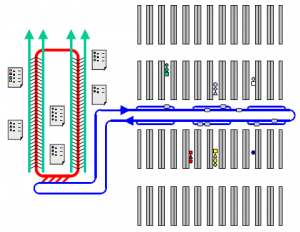In contrast to single-stage picking, with two-stage picking several orders are bundled into one overall order, a so-called commission, article-oriented picking and only later order-oriented packed. The use of a downstream sorting instance allows the order to be largely detached from the order reference during picking.
In two-stage picking, the processes of picking and compiling customer orders are handled separately. As a rule, for different numbers of orders, the entire quantity of an identical article is selected simultaneously during picking – the so-called storage unit (carton or other container) only has to be started once in the best case.
Two-step picking: 10,000 articles in one batch not uncommon
Optimal use of multi-stage picking has much better efficiency than single-stage order picking. In the first stage, the overall order determines which articles are picked. In the second or third stage, the articles of the overall order are distributed to the individual customer orders. Usually, this process step uses special conveyor systems: So-called sorting and distribution systems, also known as sorters. Today, the latter have up to 800 chutes. Each chute transports up to five orders to the packer. There, the individual articles are merged according to the orders.

By eliminating the order reference, the filling level of the individual picking container can be increased considerably. Batches of only up to six orders were standard at that time. Today, up to 10,000 articles are bundled into one batch. Furthermore, there is no need to move each container sequentially through the entire warehouse. The container frequencies in the individual storage areas drop sharply, and the performance limits of the conveyor system are less stressed. Sorting to the individual orders can be handled either by a fully automatic sorter, such as a linear sorter or by manual sorting picking at special sorting stations.
The author Timm Gudehus assumes the following for the economic efficiency of two-stage order picking – with a high number of orders:
- Many orders (more than 1,000) with few items (two to five items per order)
- Small withdrawal quantities (up to ten items) with a wide range from 10,000 items
- Orders with many items or a large withdrawal quantity
- Scheduled incoming orders with batch dispatch – up to four different dispatch cycles per day
- Tangible and easy to handle piece goods or weights
- Rush orders, orders with special handling
- High workload per shift – at least eight hours
In his book “Logistik, Grundlagen, Strategien, Anwendungen”, 3., revised edition, Gudehus estimates that the prerequisites for two-stage picking are given, for example in the mail order business and pharmaceutical wholesale.
Michael ten Hompel and Thorsten Schmidt argue similarly. In the specialist book “Warehouse Management – Organisation and Control of Warehouse and Picking Systems”, both require the following characteristics for article-oriented picking: :
- Good conveyability of the picking unit with similar dimensions and handling characteristics
- Computer-aided order preparation and combination for sorting the picking units and allocation to customer orders
- Sufficient compaction of incoming orders, i.e. sufficient quantity of orders for so-called stack formation with largely the same priority
To obtain a better comparison to single-stage order picking, one only has to consider the conventional process organization or the effort of a single order picking:
- Base time: Acceptance of the order, sorting of documents if necessary, picking of containers, delivery of goods and containers as well as forwarding or processing of documents.
- Picking time: Picking up the goods, lifting the goods, transporting or parking the goods or removal unit.
- Dead time: reading, opening cartons, searching for and identifying goods, checking the goods and reacting to new orders and, if necessary, special orders.
- Travel time: Driving or going to/from the acceptance point, removal point and delivery point. Important: The distance can be several kilometres per day. Well-programmed WMS software now tries to avoid long distances for employees.
For further information, read the articles Order Processing and Order Disposition in Intralogistics.
Teaser picture: tgw-group – Presse
Warehouse management - as simple as possible, as complex as necessary
Our WMS offers you an individually tailored, lean and process-oriented warehouse management.

Also available in Deutsch (German)